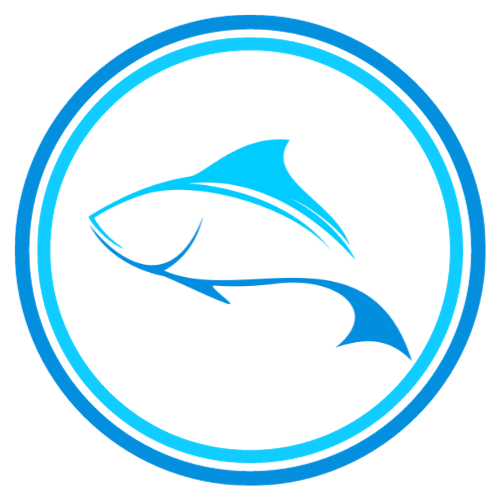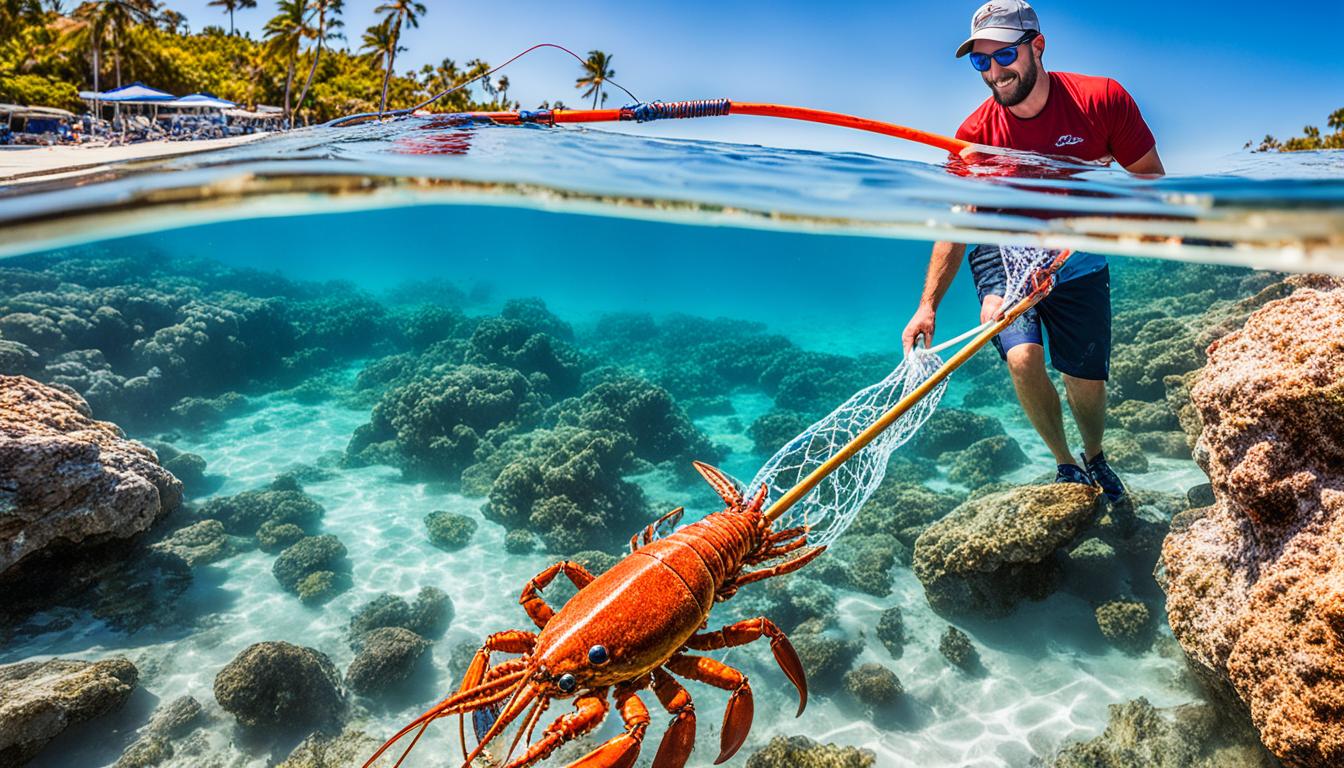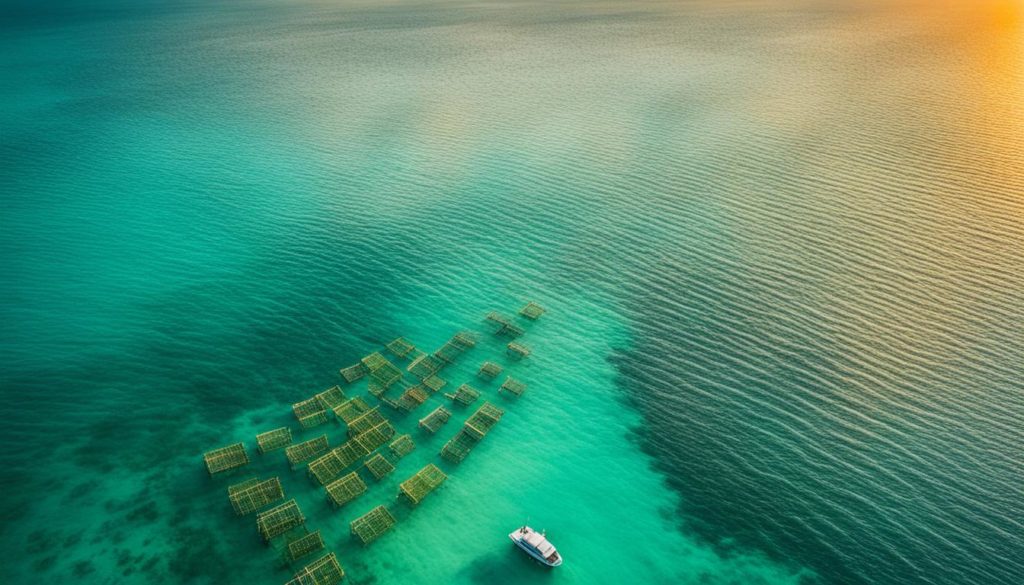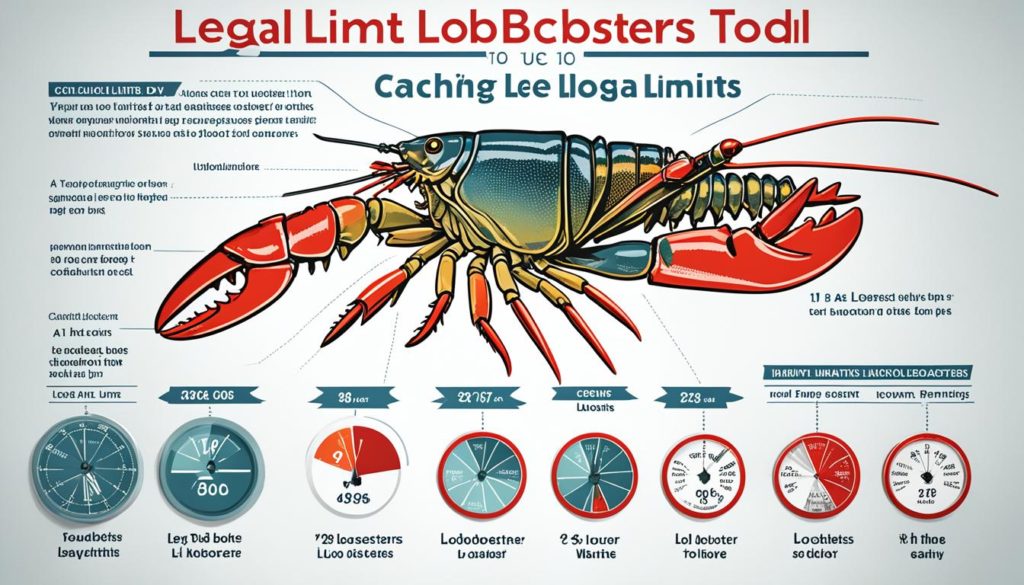If you’re looking for an exciting adventure in the waters of Florida, lobster catching is a popular activity that offers both adrenaline and delicious rewards. Florida is known for its abundant lobster population, making it a prime destination for lobster enthusiasts.
Whether you’re a seasoned lobsterer or a beginner eager to dive into the sport, this guide will provide you with valuable tips and tricks to catch lobsters successfully in the beautiful waters of Florida.
Key Takeaways:
- Florida is renowned for its thriving lobster population, providing ample opportunities for lobster catching adventures.
- Knowing the lobstering regulations and obtaining the necessary permits and licenses is crucial before embarking on your lobster catching trip in Florida.
- Preseason scouting and paying attention to clues such as bare spots on rock ledges can help you find the best lobster spots in Florida.
- There are various lobstering techniques you can employ, such as using a tickle stick or snares, to capture lobsters effectively.
- Understanding the legal lobster limits is essential to protect the lobster population and adhere to conservation efforts.
Lobstering Regulations in Florida
Before you head out to catch lobster in Florida, it’s important to know the regulations and rules that govern lobstering in the state. In Florida, lobster season has specific dates and limits on the number and size of lobsters you can harvest. It’s also important to have the necessary fishing license and lobster permit.
Familiarize yourself with the specific regulations for the area you’ll be lobstering in to ensure compliance and the protection of the lobster population.
Florida has a set lobster season that typically runs from August 6th to March 31st. During this period, you are allowed to catch lobsters. However, please note that there are specific dates during the season where the lobstering is prohibited. These closed seasons are implemented to protect lobsters during their breeding and molting periods.
- Size Limits: Lobsters caught in Florida must meet certain size requirements. The carapace, which is the body shell excluding the tail, must be larger than 3 inches. This measurement is taken from the rear of the eye socket to the rear of the carapace. Keeping smaller lobsters is illegal as it allows them to grow and reproduce.
- Bag Limits: The bag limit specifies the maximum number of lobsters an individual can catch in a single day. In most areas of Florida, the bag limit is 12 lobsters per person, per day. However, in Monroe County and Biscayne National Park, the limit is reduced to 6 lobsters per person, per day. These bag limits are in place to prevent overfishing and ensure the sustainability of the lobster population.
- Special Permits: In addition to a regular saltwater fishing license, you will need a spiny lobster permit to catch lobsters in Florida. This permit can be obtained online or from authorized vendors. Make sure you have both your fishing license and lobster permit with you while lobstering to avoid any legal issues.
This table provides a summary of the lobstering regulations in Florida:
| Regulation | Details |
|---|---|
| Lobster Season | August 6th to March 31st |
| Size Limits | Carapace must be larger than 3 inches |
| Bag Limits | 12 lobsters per person, per day (except in Monroe County and Biscayne National Park where it is 6 lobsters) |
| Permits | Regular saltwater fishing license and spiny lobster permit required |
It’s important to familiarize yourself with these regulations and abide by them to protect the lobster population and ensure the sustainability of this valuable resource.
Finding the Best Lobster Spots in Florida
When it comes to lobstering in Florida, one of the most crucial factors for a successful catch is finding the best lobster spots. It’s all about identifying the areas where lobsters are abundant, and there are a few strategies that can help you in your quest.
Preseason Scouting:
Before lobster season begins, it’s a good idea to do some preseason scouting. This involves researching and gathering information about the different diving locations in Florida. Look up local forums, talk to experienced lobsterers, and consult with dive shops to get insights on where the best lobster spots might be.
Clues during the Dive:
Once you’re in the water, keep your eyes peeled for clues that indicate the presence of lobsters. Look for bare spots on rock ledges, as lobsters often hide in crevices and holes. Certain fish species, such as triggerfish and hogfish, are also known to hang around lobster hideouts. If you notice these fish, there’s a good chance that lobsters are nearby. Additionally, pay attention to recurring patterns in the places you dive. Lobsters tend to have their favorite spots, so if you consistently find lobsters in a particular area, mark it as a potential hot spot.
Exploring different areas is key to finding the best lobster spots in Florida. Don’t be afraid to venture beyond the popular dive sites and discover new locations. Sometimes, the less crowded areas can yield better results. Be patient and persistent, as not every dive may lead to a significant lobster catch. Remember, the thrill of lobstering is not only in the catch but also in the adventure of searching for these prized crustaceans.
By combining preseason scouting, paying attention to underwater clues, and exploring different areas, you’ll increase your chances of finding the best lobster spots in Florida. Happy lobstering!
Lobstering Techniques in Florida
When it comes to lobstering in Florida, there are various techniques you can employ to increase your chances of a successful catch. Whether you’re a seasoned lobsterer or a novice, mastering these techniques will enhance your lobster-catching adventures. So, let’s dive in and explore the different methods you can use to catch lobsters in Florida.
1. Tickle Stick Technique
The tickle stick technique is a popular method used by many lobsterers in Florida. This technique involves using a tickle stick to block the lobster’s retreat and then swiftly grabbing it with a gloved hand. The tickle stick helps you corral the lobster and minimize the risk of injury during the capture process.
2. Snares and Nets
Another effective technique is using snares or nets to capture lobsters. Snares are loops with a handle that can be tightened around the lobster’s body, securing it for retrieval. Nets, on the other hand, are used to scoop up lobsters from their hiding spots. Both methods require precision and patience to avoid causing harm to the lobsters or damaging their habitats.
3. Gentleness and Patience
Regardless of the technique you choose, it’s essential to be gentle and avoid sudden movements that could startle the lobster. Lobsters are known to be skittish, so taking your time and approaching them calmly will increase your chances of a successful catch.
4. Judging Lobster Size
Learning to judge the size of lobsters underwater is crucial to ensure you only keep legal-sized ones. In Florida, there are strict regulations regarding the minimum size that lobsters must meet to be harvested. Using a lobster measuring tool can help you determine if a lobster is within the legal size limits.
5. Practice Makes Perfect
Mastering lobstering techniques takes practice and experience. Each successful catch will boost your confidence and refine your skills. The more time you spend honing your techniques, the better you’ll become at identifying lobster hiding spots and executing precise captures.
Remember, the key to a successful lobster-catching adventure in Florida is not only employing the right techniques but also respecting the lobster population and their habitats. Now that you’re equipped with these lobstering techniques, get out there and enjoy the thrill of catching lobsters in the beautiful waters of Florida.
| Technique | Description |
|---|---|
| Tickle Stick | Uses a tickle stick to block the lobster’s retreat and then captures it with a gloved hand. |
| Snares and Nets | Utilizes snares or nets to secure and retrieve lobsters from their hiding spots. |
| Gentleness and Patience | Emphasizes the importance of being gentle and patient to avoid startling the lobsters. |
| Judging Lobster Size | Highlights the need to accurately determine the size of lobsters to comply with legal regulations. |
| Practice Makes Perfect | Encourages continuous practice to improve lobstering skills and increase success rates. |
Legal Lobster Limits in Florida
To protect the lobster population and ensure sustainability, there are legal limits on the number and size of lobsters you can harvest in Florida.
The daily bag limit for lobsters in Monroe County and Biscayne National Park is six lobsters per person, while in the rest of Florida, it is 12 lobsters per person.
It’s important to adhere to these limits to avoid fines and contribute to the conservation efforts for Florida’s lobsters.
| Location | Daily Bag Limit |
|---|---|
| Monroe County and Biscayne National Park | 6 lobsters per person |
| Rest of Florida | 12 lobsters per person |
By adhering to these legal lobster limits, you can enjoy the thrill of lobstering while also ensuring the long-term sustainability of Florida’s lobster population.
Using Lobster Traps in Florida
While commercial lobstermen often use lobster traps or “pots” to catch lobsters, recreational lobsterers in Florida typically catch lobsters by hand or using other techniques. However, some recreational divers may also choose to use lobster traps.
Lobster traps are designed to attract lobsters and provide an easy way to capture them. They can be baited with fish or other lobster favorites and then submerged in areas where lobsters are known to be present. The traps have openings that allow the lobsters to enter but make it difficult for them to escape.
Checking traps regularly and removing harvested lobsters is important to comply with regulations and ensure the well-being of the trapped lobsters.
| Pros of Using Lobster Traps | Cons of Using Lobster Traps |
|---|---|
| Can attract a larger number of lobsters at once | Requires regular checking and maintenance |
| Provides a passive method of catching lobsters | Can be more expensive than other methods |
| Can be left unattended for longer periods | May not be as exciting as catching lobsters by hand |
Despite the advantages of using lobster traps, it’s essential to remember that recreational lobstering in Florida is primarily done by hand or using other techniques. This ensures a more engaging and hands-on experience, allowing you to fully appreciate the thrill of the catch.
Lobster Trapping Tips:
- Place traps in areas with known lobster populations.
- Bait traps with fish or other lobster favorites.
- Secure traps properly to prevent them from drifting away.
- Check traps regularly to remove captured lobsters and comply with regulations.
- Follow size and quantity restrictions for harvested lobsters.
If you decide to use lobster traps for recreational lobstering in Florida, make sure to familiarize yourself with the specific regulations for trap usage in the area you’ll be diving. Always prioritize the well-being of the lobsters and their sustainability.
Catching Lobster by Hand in Florida
Catching lobsters by hand is a thrilling and popular method among recreational lobsterers in Florida. It requires skill, finesse, and patience to approach the lobster without startling it and to grab it firmly without causing harm. To increase your chances of a successful catch, consider using a tickle stick to gently corral the lobster towards your waiting hand.
The tickle stick is a versatile tool that allows you to gently prod the lobster out of its hiding spot or coax it into a suitable position for capture. By using the tickle stick, you can minimize the risk of the lobster escaping or getting injured during the process. Remember to handle the lobster with confidence and care, ensuring a safe and ethical catch.
When using the hand-catching method, it’s important to stay calm and avoid sudden movements. Start by locating a lobster, preferably tucked under a rock or hiding in a crevice. Approach the lobster slowly and gently. Take note of its size, as there are legal size limits for harvesting lobsters in Florida.
“Approach the lobster without startling it and grab it firmly without causing harm.”
Once you’re within range, carefully reach out and grip the lobster behind its claws but in front of its tail, ensuring a secure hold. Avoid grabbing the lobster by its antennae or any other sensitive appendages, as this can cause injury to the lobster and potentially result in fines for you.
As a recreational lobsterer, it’s your responsibility to respect the lobster population and the surrounding ecosystem. Always follow the regulations and size limits set by the Florida Fish and Wildlife Conservation Commission to preserve the lobster population for future generations.
Tips for Catching Lobster by Hand:
- Approach the lobster slowly and gently to avoid startling it
- Use a tickle stick to corral the lobster into a favorable position
- Grab the lobster behind its claws but in front of its tail
- Avoid grabbing the lobster by its sensitive appendages
- Be mindful of the legal size limits when harvesting
- Respect the regulations set by the Florida Fish and Wildlife Conservation Commission
| Advantages | Disadvantages |
|---|---|
| Thrilling and immersive experience | Requires skill and finesse |
| Closer connection with the lobster and the environment | Potential risk of injuries to the lobster or yourself if not handled properly |
| Puts you in direct control of the catch | May require more time and effort compared to other methods |
Lobstering Gear for Florida Waters
Having the right gear is essential for a successful lobster-catching trip in Florida. To ensure a productive and enjoyable experience, make sure you have the following lobstering gear:
Tickle Stick
A tickle stick is a fundamental tool used in lobstering to gently coax lobsters out of their hiding spots. It allows you to block their retreat and guide them towards your waiting hand for capture. Invest in a durable and reliable tickle stick to enhance your lobstering technique.
Gloves
Protect your hands from potential cuts or scrapes by wearing gloves specifically designed for underwater activities. The gloves should provide both dexterity and protection against spiny lobsters.
Lobster Measuring Tool
Florida has regulations regarding the size of lobsters that can be harvested. A lobster measuring tool will help you accurately determine if a lobster is of legal size before capturing it. Ensure your measuring tool complies with the state’s specifications.
Net
A net is a useful accessory for capturing lobsters that are too quick to catch by hand. Opt for a net with a fine mesh to prevent lobsters from escaping.
Mask, Snorkel, and Fins
A proper mask, snorkel, and fins are essential for comfortable and efficient diving. These items allow you to explore underwater areas with ease, increasing your chances of spotting lobsters and maneuvering around the reef.
Sunscreen
Protect your skin from harmful UV rays while spending long hours under the Florida sunshine. Apply a high SPF waterproof sunscreen to avoid sunburn and enjoy your lobstering adventure with peace of mind.
Dive Shirt and Socks
Consider wearing a dive shirt and socks to provide an additional layer of protection against the underwater environment and potential scrapes from rocks or coral.
Water
Stay hydrated during your lobstering trip by bringing plenty of water. The Florida sun and physical activity can quickly lead to dehydration, so it’s important to drink regularly and replenish your fluids.
Having the right lobstering gear not only improves your chances of successfully catching lobsters but also ensures your safety and comfort throughout the adventure. Invest in high-quality equipment and maintain it well to fully enjoy the thrill of lobstering in Florida waters.
Conclusion
Lobstering in Florida offers a thrilling sport and an opportunity to immerse yourself in the abundant marine life and stunning beauty of the state’s waters. By following the regulations, using proper techniques and gear, and respecting the lobster population and their habitats, you can have a memorable and successful lobster-catching experience.
It is essential to familiarize yourself with the lobstering regulations in Florida, including the specific dates, limits, and the required fishing license and lobster permit. This ensures compliance and contributes to the protection of the lobster population.
Exploring different areas and paying attention to the signs can help you find the best lobster spots in Florida. Use techniques like using a tickle stick, snares, or nets to capture the lobsters, while being gentle and avoiding sudden movements. Adhering to the legal lobster limits is crucial for the long-term sustainability of the lobster population.
Whether you choose to use lobster traps or catch lobsters by hand, having the right gear is essential. A tickle stick, gloves, a lobster measuring tool, a net, a mask, snorkel, fins, and sunscreen are some of the gear you should have. Ensure your gear is well-maintained and functional, and remember to stay hydrated throughout your lobstering adventure in Florida.
Enjoy the thrill of catching lobster in Florida, but always prioritize safety and conservation. By respecting the regulations, employing proper techniques, and appreciating the beauty of the state’s waters, you can have a fulfilling and sustainable lobster-catching experience in the Sunshine State.
FAQ
How do I catch lobster in Florida?
There are several techniques you can use to catch lobsters in Florida, such as using a tickle stick and grabbing them by hand, or using snares or nets to capture them.
What are the lobstering regulations in Florida?
Florida has specific regulations for lobstering, including season dates, limits on the number and size of lobsters you can harvest, and the requirement of fishing license and lobster permit.
Where can I find the best lobster spots in Florida?
The best lobster spots in Florida can vary, but you can look for bare spots on rock ledges or certain fish species as indicators. Preseason scouting and exploring different areas can help you locate productive spots.
What are the lobstering techniques used in Florida?
In Florida, common lobstering techniques include using a tickle stick and grabbing lobsters by hand, as well as using snares or nets to capture them. Mastering these techniques requires practice and experience.
What are the legal limits for catching lobsters in Florida?
The daily bag limit for lobsters in Monroe County and Biscayne National Park is six lobsters per person, while in the rest of Florida, it is 12 lobsters per person. It’s important to adhere to these limits to contribute to lobster conservation efforts and avoid fines.
How do I use lobster traps in Florida?
While recreational lobsterers in Florida typically catch lobsters by hand, some may choose to use lobster traps. Lobster traps can be baited with fish and submerged in areas where lobsters are present, and they have openings that allow lobsters to enter but make it difficult for them to escape. Checking traps regularly is important.
How do I catch lobster by hand in Florida?
Catching lobsters by hand requires skill and finesse. Using a tickle stick to gently corral the lobster towards your hand can be helpful. Approach the lobster with patience and confidence to ensure a successful and ethical catch.
What gear do I need for lobstering in Florida waters?
Essential gear for lobstering in Florida includes a tickle stick, gloves, a lobster measuring tool, a net, a mask, snorkel, fins, sunscreen, a dive shirt, socks, and plenty of water for hydration.
How can I conclude my lobstering adventure in Florida?
By following the regulations, using proper techniques and gear, and respecting the lobster population and their habitats, you can have a memorable and successful lobster-catching experience in Florida.



